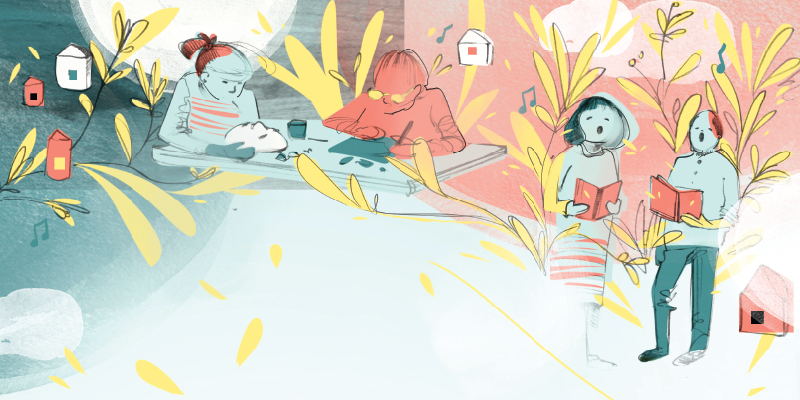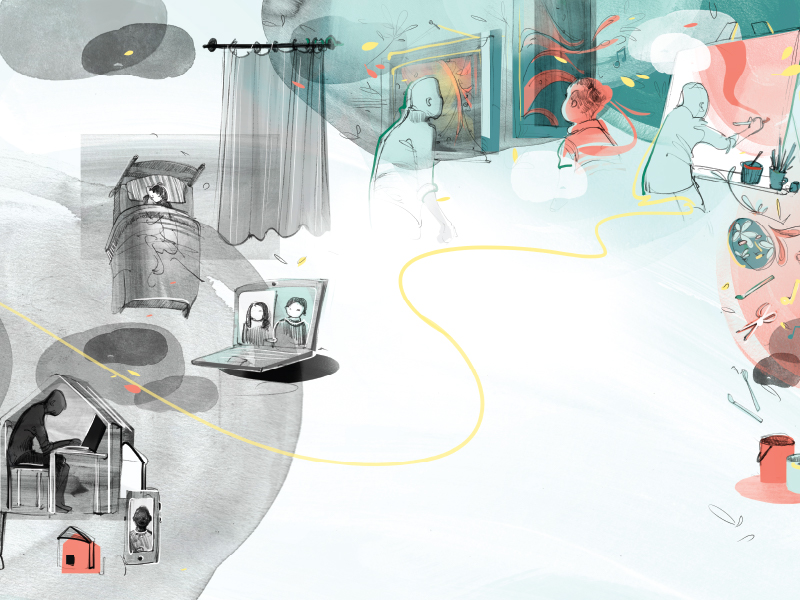Create Calgary: Artfully Resisting Isolation
Why Calgarians need the arts for their well-being
This article was originally published in Create Calgary, a new arts magazine launched by Calgary Arts Development in 2022 to celebrate the work of artists who call Mohkinsstsis/Calgary home. You can pick up a free copy at public libraries, community recreation centres and other places where you find your favourite magazines. You can also read the digital version online here.
The COVID-19 pandemic and subsequent public health measures didn’t create new social trends, but sped up existing ones. Screen time increased, economic inequality soared and working from home became the norm for many. Existing mental health trends were no different. In 2019, the World Health Organization reported that one in eight people worldwide were living with a mental disorder. In 2020, that number increased by an estimated 28 per cent. An Angus Reid survey conducted in partnership with the CBC in March 2022 reported 54 per cent of Canadians said their mental health was worse since pandemic measures began, versus 12 per cent who said it had improved.
The health measures were necessary to protect the wider population from the coronavirus. But, they created a challenging paradox. On the one hand, you can minimize infection through social isolation, but on the other, isolation increases the risk of other chronic diseases. A report from the National Academies of Sciences, Engineering and Medicine, states how social isolation accounts for a 50 per cent increase in dementia risk, 29 per cent increased risk of heart disease, 32 per cent increased risk of stroke, and much higher rates of depression, anxiety and suicide.
COVID highlighted the essential connection between mental health, social bonds and physical well-being. This connection may seem obvious, yet, typically, it isn’t considered when people with illnesses are diagnosed. David Matthews, a lecturer on sociology and social policy from Wales, U.K., writes about this in his 2019 essay, “Capitalism and Mental Health.” Matthews says there’s an intimate connection between mental health and social conditions often not fully considered when people are diagnosed with a mental health illness. Instead, the focus is usually on biological explanations, such as chemical imbalances in the brain.
In his essay, Matthews also talks about German social psychologist Erich Fromm’s five essential human needs as they relate to social connection and our well-being: relatedness, rootedness, transcendence, sense of identity and frame of orientation. Relatedness is the awareness of being alone in the world and the need for individuals to connect. Rootedness is the psychological requirement for a sense of belonging. Transcendence is about the expression of creativity. Identity is our sense of self that comes from “an awareness of being a specific person.” And, finally, orientation is how we interpret the world and navigate human experience.
If we assume that satisfying these five essential human needs is necessary to our well-being, it is obvious why the pandemic era has been so hazardous to our mental health. It’s nearly impossible to achieve relation to others, rootedness, creative expression, self-identification or orientation in a world of sudden isolation.
But, it is not as though COVID seared through a world where our needs were being met. Pre-COVID, we were already becoming increasingly isolated by smartphone culture, the commodification of social spaces, job insecurity and urbanization that pulled many from community and family roots.
Pandemic or not, this trend toward isolation has undoubtedly played a large role in the current mental health crisis. In a 2009 article in the American Journal of Public Health, public health experts Heather L. Stuckey and Jeremy Nobel note that stress and depression contribute to poor cardiovascular health, along with a myriad of other negative impacts on our overall quality of life.
Healing through the arts
If there should be one takeaway from life in the present age, it is that community is essential, especially when times are hard. And, one way to combat our sense of isolation is through the arts.
From visual art to singing, theatre and more, art is increasingly recognized as an expression that can neutralize the damaging effect of isolation at work many of us experience today. In a 2020 article in The Conversation Canada, Brittany Harker Martin, an arts education specialist at the University of Calgary, reported on medical research taking place around the world. Harker Martin says brain imaging reveals that art significantly benefits four areas of our consciousness: creativity, stress-relief, cognitive abilities and a sense of purpose.
These benefits aren’t a surprise to Karly Mortimer, director of artist and program development at the National accessArts Centre (NaAC) in Calgary, the country’s oldest disability arts organization. “Arts are integral to feeling connected and being able to process your experience as a human,” she says. Since 1975, NaAC has used the arts to connect a community of artists who are living with a disability. The City of Calgary is one partner that has commissioned NaAC artists to create public art, such as utility-box art designs and painted buoys that hang over Devonian Gardens. NaAC artists are paid professional fees for their commissioned work and all public presentations of their work, which is important. But, COVID-19 showed that payment wasn’t the primary motivation.
“We lost some of our artist population during the pandemic,” Mortimer says, recalling the tragic loss of life experienced by this medically vulnerable community over the past couple of years. “But, through that, we learned the arts were integral; that was the most important thing. We had some artists whose families said, ‘I know they are holding onto life to finish a project at the NaAC.’ We reaffirmed at that point that the arts were not auxiliary, a nice participation program, but really that they were integral to living.”

Connecting with the arts in Calgary
Art is a universal language. Calgary art therapist and community connector Allan Rosales says the benefits of art are available to most Calgarians. “There is not an opportunity for everyone to see a counsellor, or see a psychologist or have access to those things, whereas the arts are very accessible,” Rosales says.
Rosales previously worked as the coordinator of the Healing Arts Program for CancerControl Alberta at Alberta Health Services. The program partners with patients receiving cancer treatment and their family members and offers support from first diagnosis to palliative care and end of life. Support ranges from art care packages, art classes, musical performances at the Tom Baker Cancer Centre, individual art therapy sessions and curated art exhibitions in the hospital hallways. Even just viewing art is beneficial. In a 2012 National Collaborating Centre for Indigenous Health publication, research facilitator Alice Muirhead and writer Sarah de Leeuw reported that art has “powerful effects on an individual’s perception of pain, their attitude and their emotional state. Health professionals report that, after viewing art, their patients are relaxed and more likely to be hopeful and optimistic.”
And, the benefits associated with viewing art are free to anyone willing. Calgary visual artist Dick Averns has lived with depression and anxiety and was diagnosed with Tourette syndrome in middle age. He has led large-scale art projects and workshops, taught art as social practice and emphasizes its positive impacts on mental health. He recommends visiting galleries as an entry point for those new to the art scene, including galleries like the Herringer Kiss Gallery in Sunalta, which counts Averns among its stable of artists. “Some people can feel threatened going to an art gallery, but it may feel like a safer space than a group-counselling session on anger management, or having to make the first step to contact a counsellor, therapist or health professional,” he says.
While visiting galleries and the City’s public art collection offer great access points for people to engage and interact with visual art, creating art ourselves is also beneficial.
“Given the opportunity, everyone can be creative. Thus, making art can be a viable alternative to just opting to look at art, and making art can yield added values,” Averns says. “The process of art-making can be contemplative. You see something from your results. When you pick up your sketchbook or something you have drawn and put on the wall, it’s an analogue, a tangible object with enduring presence.”
Local art-focused peer groups can be readily found at meetup.com, with groups such as the Calgary Sketch-Bookers or Calgary Community Choir always open to new participants. Another organization offering classes is WP Puppet Theatre Society (WPTS). For over 30 years, WPTS has brought its programming to Calgarians of all ages, presenting original puppet performances and unique learning opportunities. It encourages participants to connect through the power of puppetry. In 2014, WPTS developed VIEW From the Inside — a program specifically dedicated to promoting mental well-being. This typically eight-week course is delivered in-person or online and encourages participants to tell their own stories by creating and performing their own self-portrait puppet. More than 600 people have taken the course, including high school students and organizations seeking to strengthen relationships amongst their members. In 2018, WPTS received the ATB Financial Healing Through the Arts Award for the program. The award was created to promote the healing nature of the arts and recognizes artists whose work focuses on health and wellness as a way to improve the well-being of individuals or communities.
“The power of a puppet lies in its being a metaphor or a symbol,” says Wendy Passmore- Godfrey, founder and artistic director of WPTS. “People can talk through the puppet and gain an objective view, an outsider’s view back onto themselves. A lot of people coming out of the VIEW program say, ‘I never knew I felt this or that way,’ or, ‘I learned this about myself.’ Self-realization is a key part of VIEW. There’s an ability to tell a story and change a story if you want to.”
Puppetry is a fully immersive experience in this way, intensely individual and social all at once. And, this might be the promise that the arts hold as the basis for community and well-being, whether it’s musical or visual, literary or performative. “The arts are so close to our humanity, we cannot separate ourselves from that,” says Rosales. “And, when we connect with art, we connect deeper with ourselves.”
The pandemic has been hard on society and individuals. Those in the arts are no exception. But, in interviews with artists working in the field, they reported a resurgence of interest and participation over recent months. Anecdotal, but interesting when considering the shouting headlines about the struggle to recapture that elusive pre-COVID way of life. And maybe that’s the point. As a new future emerges in the meltwater of the pandemic freeze, the arts provide all the tools necessary to leave the old world behind and colour in the new.
